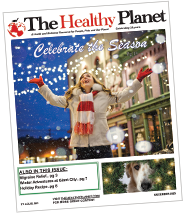With Jean Ponzi
As The Crows Fly
Our office move occurred in the dead of winter. The transit from a quiet tree-green suburban neighborhood to stark concrete city left me feeling shocked and grim. I hated being there, deprived of any hint of nature.
Then one workday’s sunset hour, a swoop of dark shapes caught my attention. Winged clouds of big bodies, black against the flaming sky, swarmed past my desk window, swirling westward toward the sun.
From that day until spring buds revealed real life in a man-made wasteland, I watched crows fly in almost every twilight. They carried me through a desolate season, and helped me make peace with a big move.
Crows are intensely social creatures, and they are clever opportunists. They’ve learned to thrive on the foibles of human society.
Throughout fall and winter nights, crowds of crows roost together in cities. The heat sinks of our buildings and pavement keep urban centers warmer than the outlying open regions crows prefer for daytime doings. The slimmest strips of treetop shelter along our well-lit parking lots offer vigilant crows a lookout advantage over any predators.
Year after year, generations of crows use the same flight paths and roosting grounds, where abundant human trash and food scraps turn these mass roosts into Black Bird Bistros. Flocks of crows – hundreds of birds – arrive at dusk, wheeling and careening as they did the day my spirit joined them. They chatter, preen, feed, fight and PAR-TAY into the evening. Before dawn, they disperse alone and in small family groups to far-flung foraging grounds, where their motley natural diet includes road kill, insects, small frogs, lizards, snakes, seeds, and the eggs and young of other birds.
Members of the family Corvidae – including crows, jays, ravens, rooks and magpies – are second in intelligence only to parrots, among all birds. Studies have shown crows to be as smart as dogs! Amateur and professional crow-fanciers share observations of crow behavior at www.crows.net, where a working hypothesis that crows are a cognitive species with fully developed culture and language has documented 25 different crow calls.
One summer afternoon, as my friend Laura was sunning alone by the lake on her farm, she heard what she thought were people conversing in another language. Startled, she called out: “Hello?” Then she saw it was two crows, chattering in a nearby tree.
Crows combine communication with communal habits to overcome predators, such as owls, hawks, raccoons and opossums. Mobbing is a cooperative defense. A crow that spots a threat will give an assembly call, then every crow in earshot will fly in and mob the intruder. A defense call from a crow under attack will bring many other crows flapping and cackling to its aid.
Intrepid crows like the highest places. A sailor’s observation spot is a ship’s Crow’s Nest. In the first winter months my husband and I lived in our city home we observed hosts of these phantom neighbors, well established on our turf. One violently gusty, snowy night, I stood at a window to watch the storm. The white-night snowfall aura reflected up into the forms of bare trees. Silhouetted across the thinnest, topmost branches, dozens of crows were riding the wind-whipped bend and sway.
Corvids have the largest birdbrains in relation to their size. A species with a bigger brain is more adaptable, but crows and their cousins are vulnerable too. Mosquito-born West Nile Virus, causing inflammation of brain tissue, is fatal to birds in this family. Mid-continent trends toward hotter, wetter summers and milder winters support mosquito proliferation. After the country’s first bird viral victims were identified in 1999, corvid populations drastically declined from east coast to Midwest.
Crows are easy to identify by their size, cocky bearing and coloration. Crow features are entirely black – beak, eyes, feet – and their feathers flash iridescent violet in strong light. After several summers of disease, they became conspicuous in their absence. In that sad time, I watched for crow flights through each fall, hopeful at my office window as the sky blushed red, but there were no swirling flocks of crows. They recovered, because any survivors passed immunities on to their descendants, but this region’s crow revival took long years to restore such a wild presence.
Driving home from work now, I like to take different routes, sometimes city streets, sometimes the highway. I keep one eye on the sky, scanning the blue and scarlet clouds, peering westward toward the sun. Some days when I spot that flow of black forms flying, I turn and track ‘em.
I open the car windows to hear that crow language – squawking, shrieking, raucous! “Where’s the party, boys?” I holler. Up on roof edges or in scraggly winter treetops, black dots across the skyscape rollick in the chilly breezes.
Jean Ponzi hosts the weekly environmental talk show “Earthworms.” Listen live Mondays, 7-8 p.m. on FM-88 KDHX or pick up a podcast anytime at www.kdhx.org/ondemand.


